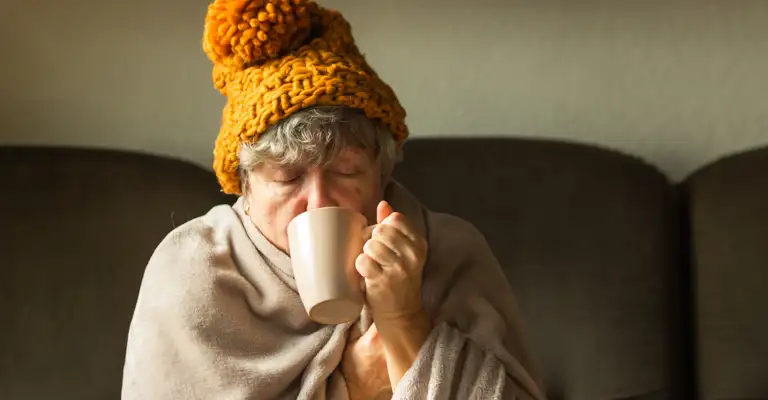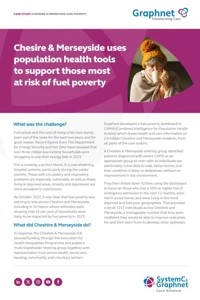Cheshire & Merseyside uses population health tools to support those most at risk of fuel poverty
28 February 2024
What was the challenge?
Fuel prices and the cost-of-living crisis have barely been out of the news for the past two years, and for good reason. Recent figures from The Department for Energy Security and Net Zero have revealed that over three million low-income households were struggling to pay their energy bills in 2023.
This is creating a perfect storm. It is overwhelming hospital systems, particularly during the colder months. Those with circulatory and respiratory problems are especially vulnerable, as well as those living in deprived areas. Anxiety and depression are more prevalent in cold homes.
By October 2022, it was clear that fuel poverty was starting to bite across Cheshire and Merseyside, including in St Helens where estimates were showing that 42 per cent of households were likely to be impacted by fuel poverty in 2023.
What did Cheshire & Merseyside do?
In response, the Cheshire & Merseyside ICB secured funding through the Innovation for Health Inequalities Programme and pulled a multi-stakeholder steering group together, with representation from across health, social care, housing, community, and voluntary sectors.
Graphnet developed a fuel poverty dashboard in CIPHA (Combined Intelligence for Population Health Action), which draws health and care information on 2.6 million Cheshire and Merseyside residents, from all parts of the care system.
A Cheshire & Merseyside steering group identified patients diagnosed with severe COPD as an appropriate group to start with as individuals are particularly vulnerable to cold, damp homes, and their condition is likely to deteriorate without an improvement in the environment.
They then drilled down further, using the dashboard to focus on those who had a 50% or higher risk of emergency admission in the next 12 months, were not in a care home, and were living in the most deprived and fuel poor geographies. That provided a list of 1317 individuals across Cheshire and Merseyside, a manageable number that they were confident they would be able to improve outcomes for, and then learn from to develop other pathways.
The first project – WarmHomes for Lungs
The first project to go live was St Helens WarmHomes for Lungs in February 2023. Patients were contacted by the Community COPD Rapid Response Team at Mersey and West Lancs Teaching Hospitals NHS Trust to attend either a phone or in-person session to introduce the fuel poverty project, and to obtain their consent to share information with other agencies that could support them. Recommendations were then made depending on the needs of the individual, but could include a referral to their GP, the St Helens Wellbeing Service, or the St Helens Council Affordable Warmth Unit. Individuals were also connected with Energy Plus Projects, a charity that helps citizens in need achieve lower energy tariffs and warmer homes.
Bringing people and services together
The fuel poverty programme, with its population health and data-led approach, brings services together in a more holistic way, and enables the ICB to track results more effectively.
As of February 2024, 213 patients had been contacted through the St Helens WarmHomes for Lungs project and referred to St Helens Councils Home improvement team, resulting in 106 referrals to the Wellbeing Team, 20 referrals to the Pulmonary Rehabilitation (PR) Team, 20 patients had been onboarded to the COPD Telehealth Service, and 169 patients had received £500 payments from household support funds. A total of £ 84,500 in payments were made, and all patients have been reviewed by the specialist nursing team and offered a pulse oximeter and a warm home pack including a vitamin D Voucher. On top of that, 43 patients have received a second payment of £500 (totalling £21,500).
Feedback from residents has been positive and encouraging. Take Jo, for example. He has a dual diagnosis of COPD with primary condition pulmonary fibrosis and requires high-flow oxygen 24-hours per day. Living in a cold home, he can’t afford rising energy bills. He was also struggling to leave his home on his mobility scooter.
Jo was referred to the Affordable Warmth Team for a household assessment, referred for an occupational therapist assessment for a stairlift and ramp, and assisted to register on the Priority Services Register with an energy provider. Jo also received a medication review, which resulted in an oxygen saturation probe, oxygen concentrator and provision of a fan for fan therapy.
Jo received a replacement boiler and installation of a bespoke ramp. He is now managing his condition better; using his more efficient oxygen equipment for eight hours per day, which is more cost effective; and he has been able to access the £500 household warmth fund towards improvements.
When asked about the programme, Jo said:
I had to choose between my oxygen or heating the home - but not anymore.
Paul is another patient who has benefited from the programme. He was living in St Helens with his wife and his daughter, with mental health challenges. Local community nurses had been to see this man before, but he had never told them that he was sleeping on the couch, and his daughter was having to share a bed with his wife, due to the spare bedroom having a hole in the floor and the upstairs being covered in mould.
He opened up to his care coordinator, Stacey, who telephones the patients, finds out what their needs are and gains consent to refer them to other services. He told her that he had mould everywhere and was immediately referred to the Affordable Warmth Team. Paul has now had the hole in the floor fixed, new windows, the mould is gone, and he’s been given £500 to help heat his home. He is sleeping in his own bed again.
Prior to being provided with support, Paul had been in hospital three times. Since the project team intervened, he has not been in hospital once.
Paul and his wife told the community nursing team that the support has transformed their lives.
Thoughts from the frontline
Diane Green is a community respiratory nurse at Mersey and West Lancashire Teaching Hospital, and lead COPD nurse for the St Helens Community COPD Rapid Response. She has noticed the significant impact the work has had on the patients under her care.
It is hard not to cry when speaking about the importance of this work, and how it has helped the patients that I support. This project has really opened my eyes – it is truly proactive.
Through the Graphnet fuel poverty dashboard, we’ve been able to identify patients in need and target them in a completely different way. This is truly integrated, holistic nursing care. We use the Johns Hopkins algorithm to drill down and find patients that are in quintile one for deprivation and quintile one for poverty, but also those that have had the highest admissions over the past 12 months and diagnosed with COPD.
As nurses, at the click of a button, we now have all the information that we need for those patients to truly optimize them. We can see whether they’ve been immunized, whether they are still smokers, whether they’re optimized on their treatment, what quintile of poverty they are actually living in. That has helped us to prioritise and identify the people that are most in need.
Dianne talked through some of the tangible outcomes that she and her team have seen.
The £500 payments have made a massive difference to keeping people warm. They’ve all been optimized, they’ve all received visits from the nurses, we’ve increased our referrals to pulmonary rehab, we’ve increased our referrals to telehealth, which is something else we do to try and keep patients out of hospital.
This is truly joined up working because we’ve been working and meeting regularly with our partners to discuss what is available for our patients, what has changed, and what other facilities we can offer them.
We’ve been working in partnership with St Helens Care, with Mersey Care, with CHCP and we’ve also brought in Torus, which is our local social housing organisation, so they can help us prioritise the patients that need our help most urgently.
According to Dianne, the fuel poverty programme has been transformative.
I’ve been a nurse since 1986, and we’ve never transformed lives like this. As a community nurse, we go into patients houses but they never tell us that they can’t afford a light bulb upstairs, they never tell us that they’re really struggling to pay the bills. The difference that we’ve made by looking at them and their lives through different eyes is unbelievable.
What’s next?
The objective now is to build on the pathway that has been developed in St Helens and embed it across different places.
The next priority is a Preschool Wheeze project, which will support children aged 0-4 with an undiagnosed wheeze. This is the second cohort that has been identified as being at risk of negative health implications (including asthma) due to cold homes and a pilot project in St Helens started in December focusing on this group. Cheshire & Merseyside will also be expanding the COPD pilot and rolling it out further across St Helens, Knowsley, and Warrington.
Much has been learned during the course of the programme, namely that there is value in testing and learning from small pilot projects to support scaling up of work going forward. It has also emphasised that the people involved are crucial. The technology provides the data that is needed, but it’s the people from health, social care, and other sectors, who have put their hands up to get involved, who are the heart of the programme, harnessing those insights to provide vital, life-improving support to Cheshire & Merseyside’s most vulnerable residents.










